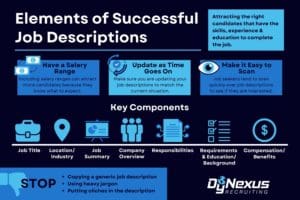Writing an Effective Job Description
“Do your job; be the best at whatever your job description is.” – Randy Moss
Are you searching for that right someone to fill your position and not having any luck? Having an engaging and clear job description is a crucial first step in attracting the right talent. This job description, when written effectively, will set the tone and foundation for your recruiting efforts. First impressions matter and that is still true with writing effective job descriptions as this might be the first time the job seeker is hearing about your company.
The job description should be clear, concise, and compelling enough to attract qualified candidates. According to LinkedIn, shorter job posts receive 8.4% more applications per view than average. This boils down to about 300 words. That being said, posts that are 601+ words also tend to do slightly better than average, earning 1% more applications per view. If you use the longer word count to share more enticing details about the role, candidates will stick around to read them. If a job seeker stumbles upon your job, but they cannot tell what the actual job entails or if it’s too lengthy, they won’t be sure if they should apply for it or not. Remember, candidates need to be convinced enough to pick your job over another company’s or to leave their current job for yours.
Aside from just listing the standard description of the role and the skills needed to fulfill that role, you should also emphasize your company’s values and culture to attract candidates whose values align with your company’s. You always run the risk of a bad hire. It’s going to happen. Writing an effective job description can help mitigate those odds. At DyNexus, we write job descriptions that are both effective and match our clients needs. We are now going to explore the 7 key components to write an effective job description.
Job Title
The job title should be clear and concise. This is not where you describe the role and responsibilities. You should make a very intentional effort to specifically label this role. Think about what potential candidates are going to search for when they are looking for their next job. While having a creative job title can showcase a little about your company’s culture, it may not always show up in a job search. Make sure that you use keywords that candidates will use in their searches.
Location & Industry
The location is going to be where the work is going to take place. This is not always where the company itself is located. The industry is the main work industry of your company.
Job Summary
When it comes to the job summary, this should be a short synopsis of why this job is important and what exactly you are looking for. Most job seekers skim over job descriptions so make sure that this section is clearly laid out for the candidate.
About the Company
Here is where you are going to provide details about your company to make it stand out. Job seekers are going to be evaluating your company just as much as you are evaluating them. This is where they will ask themselves, ‘Will I be a good fit and enjoy my time working here?’ This is your chance to brag about what makes your company great. You have a chance here to reflect your culture and values.
Responsibilities
This section details the specifics of what the job actually entails. You should make a brief, but clear and detailed list of your expectations of this new hire. If you are hiring an ERP Implementation Consultant, is this a full-cycle Acumatica or Sage Intacct implementation? Does this include post-implementation training for end users? Help your candidates see what a normal day at work would look like with your company but do it in a way where it is interesting and engaging to the candidate.
Requirements and Education/Background
This is where you will list the background and required skills that a potential candidate must have in order to be a contender for the position and complete the required tasks at a high level. You can also divide this list into two categories: Must haves and Bonus Skills.
Compensation & Benefits
The compensation range and list of benefits should be listed in a clear manner. Having these things in a job description will entice the job seeker to apply if what they see matches their needs. Consider adding a salary range to your description so applicants know what compensation they are working with before they apply. A study by LinkedIn says that 61% of candidates say the salary range is the most important part of the description.
Final Thoughts
Once your Job Description is finalized and posted, unfortunately, your work isn’t done. Sometimes you will realize some skills and requirements are more important than you originally thought. Sometimes, the first few candidates you interview can make you realize your Job Description needs some editing. The blueprint for your Job Description should remain the same, but adjusting as you go can make the rest of the hiring process much quicker and smoother.
Writing an effective job description can pave the way for a successful hiring process. Once you have caught the attention of the right potential candidates, you can focus your attention and efforts on interviewing and selecting the best candidate for the job and not on continuously sorting through resumes.


